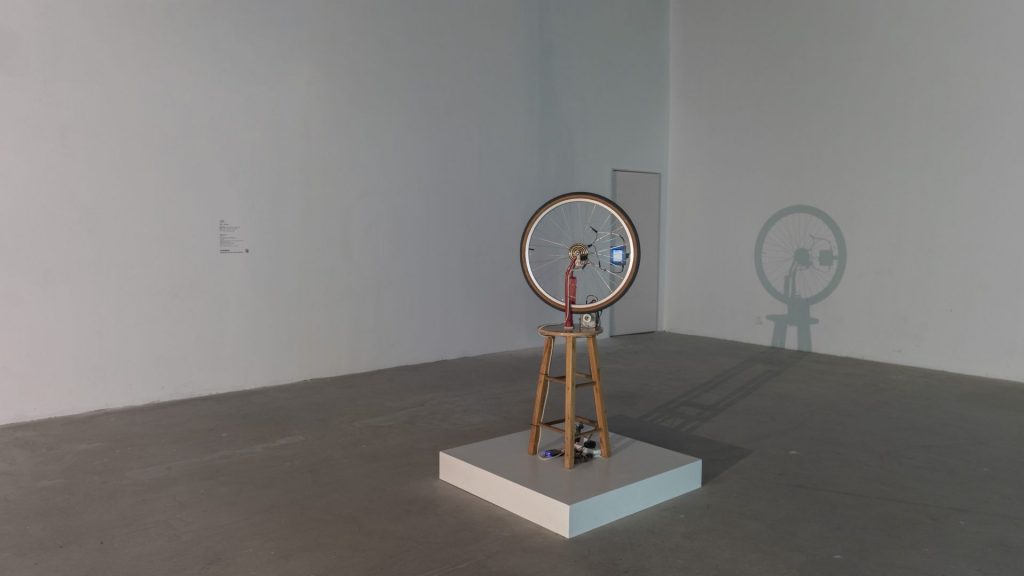Duchampiana: Bicycle Wheel One, 1990
single-channel video sculpture (1 bicycle wheel, 1 monitor, 1 stool)

Shigeko Kubota, Duchampiana: Bicycle Wheel One, 1990, single-channel video sculpture
Installation view of Refocusing on the medium: the Rise of East Asia Video Art. Image courtesy of OCAT Shanghai.

Shigeko Kubota, Duchampiana: Bicycle Wheel One, 1990, single-channel video sculpture. Installation view of Refocusing on the medium: the Rise of East Asia Video Art. Image courtesy of OCAT Shanghai.

Shigeko Kubota, Duchampiana: Bicycle Wheel One, 1990, single-channel video sculpture
Installation view of Refocusing on the medium: the Rise of East Asia Video Art. Image courtesy of OCAT Shanghai.
Kubota’s video sculptures from the mid 1970s experiment with the unique capabilities of the video medium. Kubota met Marcel Duchamp in the year of his death 1968 and made several works in video, video sculpture and installation paying homage to his works. Duchampiana: Bicycle Wheel One (1990) is a video version of Duchamp’s first recognised readymade, Bicycle Wheel (1913) as a foundation and conceptual proposition to augment with the medium of video. Kubota introduces mechanised movement to her bicycle wheel on a motionless stool and extends the portrayal of movement through the addition of video imagery within monitor attached to the spokes of the spinning wheel. This configuration, impossible to achieve in film, spirally rotates the three-inch monitor filled with natural and synthetically coloured landscape and monochromes. The imagery pushes and pulls between considering the sculpture as an expression of a journey or, as the monitor transforms to a monochrome field of purple, a more objective reality grounded in the present moment and place. The treatment of time oscillates within the sculpture, on the one hand evoking synthetic time captured in the edited video landscape while on the other hand the immediacy of the object in the present moment particularly accentuated when the monitors are monochrome. The mechanically driven turning bicycle wheel is a meditative icon, a reassuring motion of continuity holding both the humour and reverence Zen Buddhism allows to coexist. The monitor’s circular track proceeds at a moderate speed, neither fast nor slow, turning the video image around and upside down where it is possible, though unnatural, for the eye to follow. The ability to remain focused on the turning screen inevitably waivers to allow the eye to switch from the micro screen to a macro wholistic view of the sculpture. The artist said that ‘video is organic and film is not’[1] implying the relationship with the video medium through specific unique qualities such as recording processes, instant playback, editing possibilities, distortion of time, and portability, made the relationship with the video medium one that was a responsive and in dialogue. (Text / Kim Machan)
[1] Video Data Bank, “Shigeko Kubota: An Interview”, 1982, video, 22 mins, retrieved November 17, 2019, https://www.kanopy.com/product/shigeko-kubota-interview.

Image: Shigeko Kubota in her studio. ©Tom Haar, 1972. Image courtesy of Tom Haar and Shigeko Kubota Video Art Foundation.
-
- Shigeko Kubota
1937-2015, Niigata, Japan
- Shigeko Kubota
Born in 1937 in Niigata, Japan, in 1964 Kubota moved to New York, and immediately became an active participant in the international Fluxus art movement in the 1960s. She was one of the first artists to adopt the portable video camera Sony Portapak in 1967. Kubota was strongly influenced by the art and theories of Marcel Duchamp and John Cage. She brought a singular sensibility to her extensive body of video sculptures, multi-media installations, and single-channel videos. Throughout her career, Kubota forged a lyrical union of the personal and the technological, often merging vibrant electronic processing techniques with images and objects of nature, art and everyday life. Kubota’s work received two major surveys in the ’90s–one at the American Museum of the Moving Image (1991), the other at the Whitney Museum of American Art (1996).

